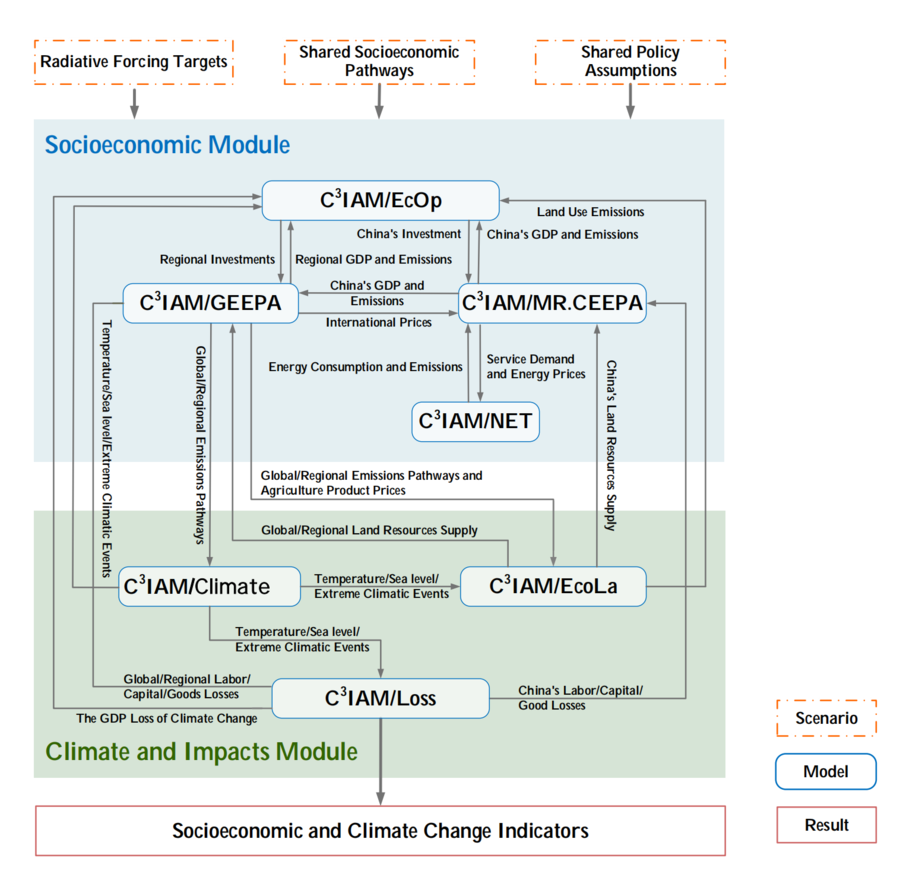Model scope and methods - C3IAM
| Corresponding documentation | |
|---|---|
| Previous versions | |
| Model information | |
| Model link | |
| Institution | Center for Energy and Environmental Policy Research, Beijing Institute of Technology (CEEP-BIT), China, http://ceep.bit.edu.cn/english/. |
| Solution concept | General equilibrium (closed economy) |
| Solution method | Optimization |
| Anticipation | |
C3IAM consists of various analytical models developed to analyze policy issues within a specific set of sectors as shown in Figure 1. These models are interlinked to provide an integrated system for assessing the impact of climate change. C3IAM considers factors such as global multi-regional, multi-sectoral economic development, greenhouse gas emissions, emission reduction costs, climate change losses module, etc. It can not only depict the social economic system in detail, but also realize a long-term balanced growth path.
To apply C3IAM, all model settings are adjusted so that the model reproduces the state-of-the-world in 2011 and cover the period 2011–2100.
C3IAM pays more attention to clarify the comprehensive impacts of climate change and it has a better performance in the following various aspects:
1. More in-depth depiction of China: to refine the emissions pathway from the perspective of regional and sectoral, the Multi-Regional CGE Model (C3IAM/MR.CEEPA) that covers 31 provinces and the multi-sector technology model (C3IAM/NET) that covers eight energy-intensive industries are developed;
2. Extension of economic model: to capture the long-term optimal economic growth and climate change mitigation dynamically, C3IAM integrates the global CGE model (C3IAM/GEEPA) and the global economic optimum growth model (C3IAM/EcOp);
3. Realizing the hard link between the earth and socioeconomic systems: the economic models are integrated with earth system model, and the two-way feedbacks could be achieved.
<figure id="fig:The general structure of C3IA">

</figure>
References
- ↑ Yi-Ming Wei, Rong Han, Qiao-Mei Liang, Bi-Ying Yu, Yun-Fei Yao, Mei-Mei Xue, Kun Zhang, Li-Jing Liu, Juan Peng, Pu Yang, Zhi-Fu Mi, Yun-Fei Du, Ce Wang, Jun-Jie Chang, Qian-Ru Yang, Zili Yang, Xueli Shi, Wei Xie, Changyi Liu, Zhongyu Ma, Jinxiao Tan, Weizheng Wang, Bao-Jun Tang, Yun-Fei Cao, Mingquan Wang, Jin-Wei Wang, Jia-Ning Kang, Ke Wang, Hua Liao, 2018. An integrated assessment of INDCs under Shared Socioeconomic Pathways: an implementation of C3IAM. Natural Hazards 92, 585-618.